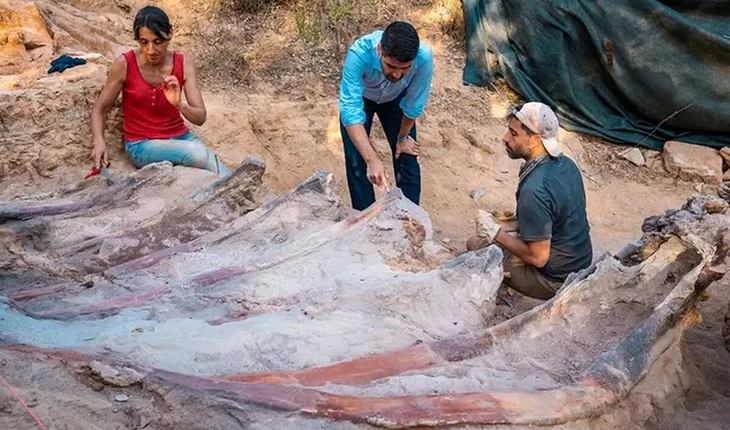
In 2017, a seemingly ordinary construction project in central Portugal would soon transform into a paleontological sensation, unveiling a fossilized sauropod that might very well be the largest dinosaur skeleton ever discovered in Europe.
This awe-inspiring revelation has captivated the world’s scientific community and ignited imaginations, offering a glimpse into the distant past and the mysterious giants that once roamed the earth.
The story begins with a Portuguese property owner embarking on renovations in his own home. While he was doing some reconstruction of his property, he stumbled upon a series of fragmented, fossilized bones concealed within the soil of his yard. Recognizing the significance of his chance discovery, he decided to promptly get in touch with scientific authorities, which then set in motion a chain of events that would bring this colossal creature back to life, albeit in the form of fossils.
It wasn’t until last month that the dedicated team of scientists and paleontologists descended upon the excavation site, excited to uncover something they didn’t realize was going to be quite so extraordinary. What they unearthed truly surpassed their wildest expectations.
Several “important” skeletal elements, potentially belonging to a dinosaur that could have stretched up to 82 feet in length, equivalent to 25 meters, were revealed. The initial findings from this incredible excavation shed light on the potential enormity of this newfound dinosaur, promising a deeper understanding of Earth’s prehistoric history.
Elisabete Malafaia, a paleontologist from the Faculty of Sciences at the University of Lisbon in Portugal, tells Agence France-Presse, “It’s one of the biggest specimens discovered in Europe, perhaps in the world.”
The primary focus of this excavation has revolved around gathering an extensive set of elements from the axial skeleton. This collection comprises vertebrae and ribs, crucial component s that provide crucial insights into the creature’s size, shape and structure.
“It is not usual to find all the ribs of an animal like this, let alone in this position, maintaining their original anatomical position. This mode of preservation is relatively uncommon in the fossil record of dinosaurs, in particular sauropods, from the Portuguese Upper Jurassic,” Malafaia adds in a statement.
These skeletal remnants have endured the test of time, with their preservation characteristics hinting at the presence of other integral parts of this magnificent dinosaur’s skeleton. The scientific community eagerly anticipates the future excavation campaigns that will strive to unearth and assemble the missing pieces of this captivating puzzle, furthering our comprehension of this ancient giant’s life and habitat.

As experts continue to meticulously study and document their findings, one of the most intriguing questions is the identification of this colossal dinosaur. Europe has witnessed the discovery of various genera of Brachiosauridae on the continent, each more fascinating than the last. This latest discovery has been proposed to belong to the Brachiosaurus altithorax, a species renowned for its monumental size and long neck, akin to the iconic Brachiosaurus known from North America. Alternatively, it could be Giraffatitan brancai, a close relative known for its massive height and elongated neck.
However, there is also the tantalizing possibility that this extraordinary specimen represents a new addition to the Late Jurassic species roster, a dinosaur indigenous to Portugal’s West region, the Lusotitan atalaiensis. The prospect of a previously undiscovered dinosaur species would be a monumental scientific breakthrough, further underlining the importance of this remarkable find.
What are your thoughts? Please comment below and share this news!
True Activist / Report a typo


